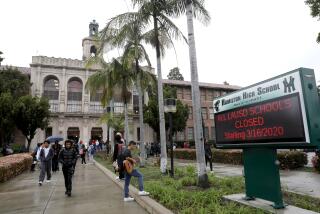10 School Districts OK Fees on Construction; 4 More Consider Them
Several Whittier and Santa Fe Springs area school districts are the latest in Southeast Los Angeles County to take advantage of a new state law and charge the owners of homes and businesses the maximum fees for new construction, despite projections that enrollment will be fairly stable for the next few years.
Initially, school districts were sympathetic to the fears of officials in some cities that the fees might discourage development. But more and more districts are deciding they do not want to pass up the chance for more revenue, and the fees have been approved largely without comment.
“I don’t think it’s a big thing,” said Richard Weaver, director of planning and development for Santa Fe Springs. “It’s probably going to happen in all the comparable areas. It’s not something that puts us at a disadvantage.”
So far, 10 Southeast school districts have adopted the fees, four are considering them and two have rejected them for now.
The law says that school districts are not entitled to the full amount of matching funds from the state for new construction unless they impose the maximum fees. That means a fee as much as $1.50 per square foot for residential construction and 25 cents per square foot for commercial and industrial developments.
For a typical new home of 2,500 square feet, the fee would be about $3,750--an amount developers have said will be passed on to buyers. A homeowner who wants to add, for example, a 12-by-15-foot room to a house would be charged about $270.
Public agencies also have to pay the fee, and cities that have requested exemptions--so they can build public facilities and housing for senior citizens and low-income residents--have largely been turned down by the school boards.
However, questions remain about the law, which took effect Jan. 1, and the manner in which districts are justifying the fees. Many school boards passed the fees with a provision calling for the matter to be reconsidered in several months, pending action by the Legislature on numerous proposals to provide exemptions.
“The law surrounding the fees is so unclear that some attorneys are recommending that if a district collects fees, to put them into an escrow account until it’s certain they can keep the money,” said Howard L. Rainey, business manager for the Nowalk-La Mirada Unified School District. “We think it’s best to take a wait-and-see approach at this point.”
The Los Nietos district in Santa Fe Springs has twice tabled action on the fees, and at its May 26 meeting decided to delay the vote another few months to see what the Legislature will do.
“There’s some mixed feelings about whether or not the fee should be imposed,” Los Nietos Supt. Terry Giboney said. “It would involve going against the city of Santa Fe Springs, which has been awfully good to us.”
Santa Fe Springs Mayor Betty Wilson said in a letter to area school districts that the city has been strongly committed to the public schools and that “in a few instances, we believe it would be inequitable for school districts to levy fees.”
The issue has drawn little interest from the community, and debate in Whittier school board meetings has been largely about whether to grant the exemptions.
“Nobody appeared to be opposed to the concept,” said Supt. John Pulice of the Little Lake Unified District, whose board voted 3 to 2 to pass the fees. “The split really came over the matter of exemptions.” He said one side wanted to grant exemptions immediately while the other wanted to await action by the Legislature.
“It’s surprising how little comment was forthcoming from the community, especially the development community,” said Jeff Keuscher, research manager for School Planning Services, a company that prepares the documentation school districts must have to justify the increase.
Under the law, districts have to show that student population eventually will increase enough to justify the fees. But districts with declining or steady enrollment want to use the law to restore deteriorating buildings in the meantime.
Whittier Planning Director Elvin H. Porter said, “We’ve had some inquiries, but usually people don’t realize it (when fees are adopted), especially the mom-and-pop type businesses.”
The new law is a provision of the School Facilities Act of 1986, designed to tap extra revenue sources to help districts build new facilities needed because of school overcrowding.
More to Read
Sign up for Essential California
The most important California stories and recommendations in your inbox every morning.
You may occasionally receive promotional content from the Los Angeles Times.









